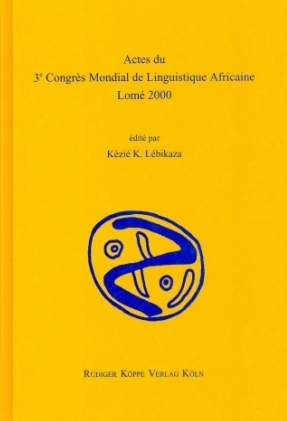


CONTENTS
I. PHONOLOGY AND MORPHOLOGY
Akinbiyi Akinlabi: Sonorant Nasalization in Yoruba Deverbal Nouns
Nancy C. Kula: On the Autonomy of the Root in Bemba
Peter Gottschligg: A Non-Rhotic Fula Dialect from Kouandé (Northern Bénin)
James S. Roberts: The Analysis of Central Vowels in Gor (Central Sudanic)
Henry Tourneux: Le système vocalique dans le groupe “kotoko”
Christian U.C. Ugorji: Towards a New Perspective for Igbo Syllable Structure
II. GRAMMAR AND LEXICON
Enoch O. Aboh: Object Shift and Verb Movement in Gbe
Marcel Diki-Kidiri: Ostension, topicalisation et focalisation en sängö
James Essegbey: On Definiteness Asymmetry in Double Object Constructions
Karl E. Gadelii: Why are Chomskyan Linguists Not Interested in Bantu Languages?
Sylvie Grand’Eury: Un dictionnaire bilingue unidirectionnel et bivalent “réduit”
K. Kézié Lébikaza: Réanalyse – le trait locatif latent dans les substantifs et ses implications semantico-syntaxiques
Doris Löhr: Locative-directional Verbal Extensions and Related Prepositions in Malgwa
Lutz Marten: The Dynamics of Bantu Applied Verbs – An Analysis at the Syntax-Pragmatics Interface
Jacques Nicole: Diathèses en nawdm (voltaïque, Togo)
Brigitte Reineke: Interaction de l’aspect et du temps en ditammari
Paulette Roulon-Doko: Le traitement des composés dans le dictionnaire bilingue – le cas du Gbaya de Centrafrique
Andreas Wetter: Ideophones in Amharic
III. COMPARATIVE LINGUISTICS
Bernard Caron: A propos de Kal et de Sigidi – problèmes de dialectologie Zaar (tchadique sud Bauchi)
Jouni Filip Maho: A Tentative Model for the Diachrony of Grammatical Gender in Bantu Languages
Nina Pawlak: The Structural Features of Plateau Hausa
Guillaume Segerer: La langue bijogo dans Polyglotta Africana
Issa Takassi: Étude comparative des classes nominales dans trois langues gurma – le gurma-tône, le moba et le ncam
IV. SOCIOLINGUISTICS
Rose O. Aziza: Threatened Languages and Cultures – The Case of Urhobo
Ayo Bamgbose: Urban Multilingualism in Nigeria – A Tale of Two Cities
Hounkpati Capo: Langues africaines pour le développement durable et la culture de la paix en Afrique
G. Tucker Childs: The African Substrate in an African Pidgin – The Case of Guinea French
Maman Mallam Garba: Les langues nationales au chevet de l’école nigérienne – craintes et espérances
Tanyi Eyong Mbuagbaw: Language Engineering in Cameroon
Ngessimo M. Mutaka / Ngoran Loveline Lenaka: The Magic World in the Nso-culture – An Ethnomethodological Study
Maria Margarida Taddoni Petter: Langues africaines au Bresil – le cas des langues secrètes
Under these links you will find further proceedings volumes of the WOCAL World Congress of African Linguistics and publications of the contributors:
The proceedings of the 3rd Congress have been edited in an exemplary way by the same Editorial House as those of the 1st and the 2nd Congress. The book constitutes a thorough overview of current trends and achievements in African linguistics, and is a sort of handbook for anyone interested in African and general linguistics.
Stanlislaw Pilaszewicz in Studies of the Department of African Languages and Cultures, 34/2003, 97-103
The origin of the World Congress of African Linguistics (WOCAL) may be traced back to the 18th Annual Conference of African Linguistics (ACAL), held in Montreal in 1987. At that meeting, Lucy Omondi and I led a movement to hold an ACAL in Africa, specifically in Kenya, although ACAL had until then always had a North American venue. There was a spirited discussion
of the pros and cons of such an innovation, and the outcome was that the 22nd ACAL was held in Nairobi in 1991. There was an intense business meeting at the latter conference, recapitulating many of the arguments of Montreal, but with the advantage of just having experienced the first ACAL outside North America. Out of this grew a resolution to start WOCAL, a new series of meetings which would rotate on some basis among Africa, Europe, and North America.
The first WOCAL was held in Kwaluseni, Swaziland (moved from Johannesburg for security reasons) in 1994, the second in Leipzig in 1997, and the third in Lomé, Togo (moved from Marrakech, Morocco, when that organizing effort fell through) in 2000. The fourth was held at Rutgers University in 2003 and the fifth is scheduled for Addis Ababa in 2006. (Note to the reader: do not confuse ACAL and WOCAL with NACAL: North American Conference on Afro-Asiatic Linguistics, also held annually, started by Robert Hetzron in 1973 at the University of California, Santa Barbara). Proceedings of the first three WOCALs are available (Herbert 1997, Wolff and Gensler 2000, and the current volume).
The volume at hand contains 31 articles divided loosely among phonology and morphology (6), grammar and lexicon (12), comparative linguistics (5), and sociolinguistics (8). Nineteen are in English and twelve in French. The languages covered fall into Afrasian (=Afro-Asiatic) five, Nilo-Saharan one, Niger-Kongo 23, and “other” two (the latter are Guinea French and a secret language of Brazil). No articles on Khoisan languages occur. Four of the Afrasian languages dealt with are Chadic (Hausa, Kotoko, Malgwa, and Zaar) and the other is Amharic (plus asides to other Ethio-Semitic languages). The Nilo-Saharan language is Gor, of Central Sudanic. The Niger-Kongo languages are concentrated in but not restricted to Togo and nearby countries; in alphabetical order: Bantu (3), Bemba, Bijogo, Ditammari, Gbaya, Ewe, Fula, Gbe, Gurma, Igbo, Naudm, Ngbaka, Nso, Sango, Urhobo, Yoruba, plus “various” two and general sociolinguistics three.
The distribution above is one of the drawbacks of an African venue: concentration both geographically and linguistically. One of the hot topics at Montreal and Nairobi was the advantage of increased access by African participants, especially students. But this is accompanied by a falloff in participants from North America, Europe, and Asia. [...]
Editorial oversight in this book is to be commended. Although many authors are not Anglophones, the English contributions have been edited to the extent so that typos and unidiomatic expressions are rare in articles I scanned.
M. Lionel Bender in WORD, 56/3, 2005, 421-426
© 2026 by Rüdiger Köppe Verlag – www.koeppe.de